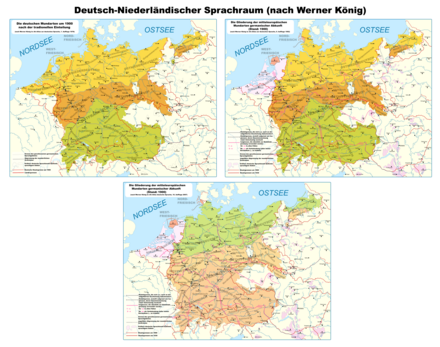East Central German dialects
The East Central German dialects are predominantly spoken in the south of the eastern federal states, which are also often summarized under the term Central Germany , i.e. primarily in Thuringia , Saxony and southern Saxony-Anhalt . There are also parts of Brandenburg and Berlin as well as border landscapes in Bavaria , Hesse and Lower Saxony .
As a result of the post-war expulsions in particular, many speakers of East Central German dialects from Silesia , East Prussia , Bohemia and Moravia came to other areas and were assimilated there. Especially around Opole there is still a Silesian-speaking German minority in Poland .
The East Frankish forms a transition to the Upper German dialects and is usually arranged there.
Dialect groups of East Central German
Thuringian-Upper Saxon dialect group
- Thuringian
- Upper Saxon
- Erzgebirge (is often assigned to Upper Saxon)
- Hallisch (partly assigned to the Eastern or Northeast Thuringian)
Lausitz-Südmärkisch in Berlin and south of it
- Südmärkisch
-
Lusatian (Saxony and Brandenburg)
- West Lusatian (Saxony around Bischofswerda )
- Upper Lusatia (Saxony around Zittau and neighboring regions, until 1945 Northeast Bohemia to Děčín / Tetschen-Bodenbach)
- Ostlausitzisch (Saxony around Görlitz and neighboring regions)
- Niederlausitzisch (Saxony and Brandenburg around Cottbus and neighboring regions)
- Neumärkisch
Silesian
As a result of the Second World War and the expulsion of most of the respective dialect speakers, the following East Central German dialects almost disappeared beginning in 1945. In Poland and the Czech Republic they are rarely spoken today. According to the 2002 Polish census, around 200,000 people in Poland still use German dialects.
- Wroclaw
- Brieg-Grottkauer dialect (Brieg-Grottkauer-Schlesisch)
- Mountain Silesian
- Glätzisch
- Herbal Mundart (Herbal Silesian)
- Envious
- Upper Silesian
- High Prussian (in East Prussia ) with Breslausch and Oberländisch
vocabulary
The vocabulary of East Central German dialects is recorded and described in the Brandenburg-Berlin Dictionary (North Upper Saxon -South Markish), the Thuringian Dictionary (Thuringian dialects), the Dictionary of Upper Saxon dialects (Upper Saxon and Lausitzian dialects), the Silesian dictionary (Silesian dialects), in the Sudeten German Dictionary (East Central German dialects from Bohemia, Moravia and Sudeten Silesia) and in the Prussian dictionary (High Prussian dialects).
Examples of the dialect
See also
- Central German dialects
- West Central German dialects
- Silesian (German dialect)
- high German dialects
- North Bohemian dialects
literature
- Beat Siebenhaar : East Central German: Thuringian and Upper Saxon. In: Joachim Herrgen, Jürgen Erich Schmidt (Hrsg.): German: Language and Space. An international handbook of language variation (= handbooks for linguistics and communication studies. Volume 30/4). de Gruyter, Berlin 2019, ISBN 978-3-11-026129-5 , pp. 407-435.
Web links
Individual evidence
- ↑ Wolfgang Jungandreas : On the history of the Silesian dialect in the Middle Ages. Studies on the language and settlement in East Central Germany. (Habilitation from the University of Breslau, 1933). Breslau 1937 (= German studies: B. Schlesische Reihe. Volume 3); Reprint, obtained from Wolfgang Kleiber, Mainz 1987.

